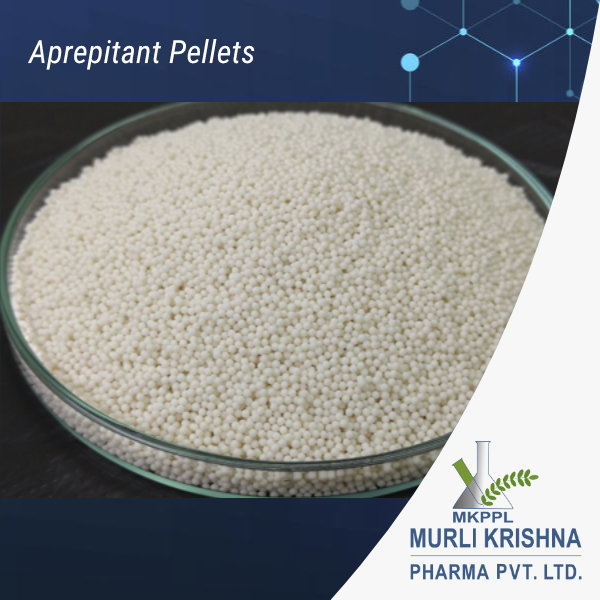Aprepitant Pellets
Aprepitant Pellets 40.0% – Ready to Fill Into Capsules (Dose: 40 mg, 80 mg, or 125 mg)
- Matches with the innovator product in terms of the dissolution profile
- Conducted and cleared multimedia dissolution studies against the innovator product
- Offers a non-infringing product
- Do offer development services in case of a requirement for different formulation/dosage/strength
- Offer complete technical package for registrations in all regulated/semi regulated markets
INDICATIONS AND USAGE:
Aprepitant is used for prevention of acute and delayed chemotherapy-induced nausea and vomiting (CINV) and for prevention of postoperative nausea and vomiting.
Aprepitant may also be useful in the treatment of cyclic vomiting syndrome & late-stage chemotherapy induced vomiting, but there are few studies to date.
MECHANISM OF ACTION:
Aprepitant is a selective high-affinity antagonist of human substance P/neurokinin 1 (NK1) receptors. Aprepitant has little or no affinity for serotonin (5-HT 3), dopamine, and corticosteroid receptors, the targets of existing therapies for chemotherapy-induced nausea and vomiting (CINV) and postoperative nausea and vomiting (PONV).
Innovator: EMEND capsules
Distributed by: Merck Sharp & Dhome Corp.
Dose: 40 mg, 80 mg, or 125 mg
The objective of developing Aprepitant pellets by aqueous technology is to match the dissolution profile of Aprepitant Pellets with Emend without use of organic solvent.
MKPPL uses non infringing manufacturing process.
Merck’s manufacturing process involves nine step process which includes:
- A slurry of Aprepitant, hydroxypropyl cellulose, and water is prepared
- The slurry undergoes pre-milling
- An aqueous sucrose dispersion is added to the slurry
- The slurry is subjected media-milling that produces a colloidal dispersion
- An aqueous sucrose dispersion is added to the slurry
- The microcrystalline cellulose beads are spray coated with the colloidal dispersion
- The coated beads are sieved
- The coated microcrystalline cellulose beads are blended with micronized sodium lauryl Sulphate
- The blended beads are encapsulated
Murli Krishna pharma follows the following process:
- Preparing nano particles of Aprepitant by encapsulating the drug in micronized acetyl alcohol (using melt extrusion) and is suspended in a medium of water, PEG, sodium lauryl sulfate and an emulsifier, that nano particles of Aprepitant remains small even after it is re dispersed from the beads
- The particle size is reduced using a high-pressure homogenizer.
- The solution is sprayed on non perile seeds comprising of lactose, starch, and microcrystalline cellulose
- The pellets are sieved post drying and are ready for filling into capsule.
- All the ingredients were available from approved vendors for FBC process. All the equipments and Analytical Instruments like HPLC, FTIR, GC, and Dissolution apparatus are available for developed Aprepitant pellets.
Plasma Study:
The Aprepitant pellets developed using Panacea API has given a plasma concentration level of 99% with reference to the Emend pellets, after being processed under similar conditions. This is in agreement with the in-vivo data which has been generated during bio-equivalence study using the Jubilant API as starting material. Hence MKPPL Aprepitant pellets using Panacea API can be expected to show similar bioequivalence as the innovator product ie Emend.
Results:
| Description of the sample (mg of drug/ml of plasma) | % of Drug dissolved in Plasma |
|---|---|
| Emend Capsules against Aprepitant Standard (2.67mg/ml) | 92.0% 90.0% |
| PDL/APF-1-090515 (2.67 mg/ml) (Aqueous process Using Panacea API) This value is with reference to Emend as a standard. |
99.62% 99.76% |
Additional Information
| Percentage | 15%, 40% |
|---|---|
| Release Type | Immediate Release |
| Target Formulations | Capsules, Injectables |
| Documentation Available: | DMF in CTD Format |
| Forms of PFI | Pellets/Micro pellets (for capsules) |
| Quality Standard | USP43 |

